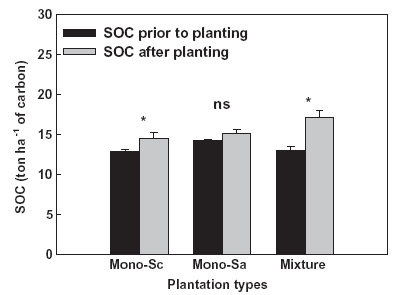Chen L, X Zeng, NFY Tam, W Lu, Z Luo, X Du and J Wang.Forest Ecology and Management, 2012. 284: 222-229.
Mangroves are one of the most carbon-rich tropical ecosystems. Two fast-growing mangrove species of the genusSonneratia, the nativeS. caseolarisand non-nativeS. apetala, have been widely used for mangrove reforestation in China; however their ability to sequester carbon is still unclear. The present study aimed to estimate the growth, carbon accumulation in biomass and carbon sequestration in sediments of these two species, in both mixed (50%S. caseolaris; 50%S. apetala) and monoculture plantations, in the intertidal zones of Shenzhen Bay, Guangdong Province, China. Twenty-five months of observation showed strong competition between the two species in the mixed plantation, with the nativeS. caseolarisoutcompeting the non-nativeS. apetaladue to a faster growth rate. AlthoughS. caseolarisin the mixed plantation had lower carbon storage in biomass than in monoculture, carbon accumulation in sediment was higher in the mixed plantation. Thus, the relative advantage of the mixed plantation was in sequestering more carbon in sediment, as opposed to high carbon accumulation to biomass. These results indicated that the mixed plantation could be a good option for mangrove restoration and carbon sequestration of sediment. However, the two and a half years of this study may not indicate long-term trends, so more research on long-term species performance is essential for successful mangrove reforestation.

Fig. 5 Soil organic carbons (SOC) in the three plantation types prior to planting and after 25 months of planting. For the differences in SOC prior to and after planting, NS represents no significant different (NS); *represents significant difference at P = 0.01-0.05.

